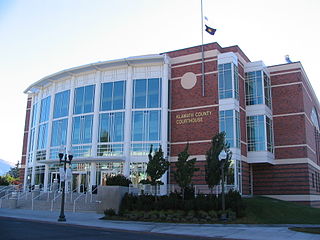
Klamath County is one of the 36 counties in the U.S. state of Oregon. As of the 2020 census, the population was 69,413. The county seat is Klamath Falls. The county was named for the Klamath, the tribe of Native Americans living in the area at the time the first European explorers entered the region. Klamath County comprises the Klamath Falls, OR Micropolitan Statistical Area.

Chiloquin is a city in Klamath County, Oregon, United States. Chiloquin was the pioneer version of a Klamath family name Chaloquin, which was the name of a Klamath chief who was alive at the time of the treaty of 1864. Southern Pacific records also show that a woman named Bessie Chiloquin deeded a right-of-way through the area to the railroad on February 14, 1914. The population was 734 at the 2010 census.

Lakeview is a town in Lake County, Oregon, United States. The population was 2,418 at the 2020 census. It is the county seat of Lake County. The city bills itself as the "Tallest Town in Oregon" because of its elevation, 4,757 feet (1,450 m) above sea level. Lakeview is situated in the Goose Lake Valley at the foot of the Warner Mountains and at the edge of Oregon's high desert country. Its economy is based on agriculture, lumber production, and government activities. In addition, tourism is an increasingly important part of the city's economy. Oregon's Outback Scenic Byway passes through Lakeview.

Dendron is a town in Surry County, Virginia, United States. The population was 251 at the 2020 census. Sculptor Leslie Garland Bolling was born in Dendron, as was mayor of Hopewell, Virginia, Curtis W. Harris.
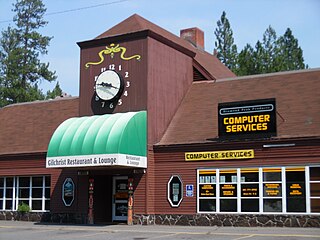
Gilchrist is an unincorporated community in Klamath County, Oregon, United States on U.S. Route 97 between Bend and Klamath Falls.
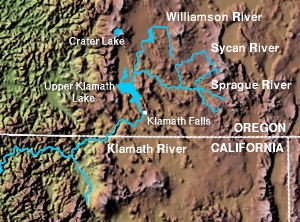
The Sprague River is a tributary of the Williamson River, approximately 75 miles (121 km) long, in southwestern Oregon in the United States. It drains an arid volcanic plateau region east of the Cascade Range in the watershed of the Klamath River.
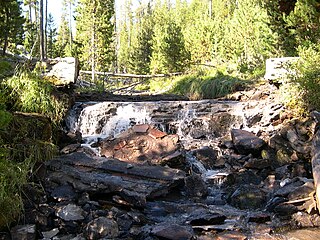
The Fremont–Winema National Forest is a United States National Forest formed from the 2002 merger of the Fremont and Winema National Forests. They cover territory in southern Oregon from the crest of the Cascade Range on the west past the city of Lakeview to the east. The northern end of the forests is bounded by U.S. Route 97 on the west and Oregon Route 31 on the east. To the south, the state border with California forms the boundary of the forests. Klamath Falls is the only city of significant size in the vicinity. The forests are managed by the United States Forest Service, and the national forest headquarters are located in Lakeview.

Algoma is an unincorporated community on the east shore of Upper Klamath Lake, in Klamath County, Oregon, United States. It is about 8 miles (13 km) north of the city of Klamath Falls on U.S. Route 97. Algoma was named for the Algoma Lumber Company.

Collins is a family-owned American forest products company that began in operations July 28, 1855. Headquartered in Portland, Oregon, Collins was the first privately owned forest products company in the United States to have all of its hardwood and softwood forests certified by the Forest Stewardship Council (FSC). In addition to its forests and sawmills, Collins also manufactures siding and trim, particleboard, hardwood, and softwood lumber, and operates retail hardware and lumber yards in northern California. Divisions include: Collins Pine Company, Kane Hardwood, Collins Hardwood LLC, Collins Products LLC, Collins Builders Supply, and the Almanor Railroad.
Mauldin or Mauldin Logging Camp is a ghost town in Montgomery County, Arkansas, United States. It is classified as a populated place. Established in 1918 by Billy Mauldin in cooperation with Thomas Rosborough, it became heavily populated by 1922 by workers drawn to industries cutting and processing virgin timber in the area. It was located between Mount Ida and Pencil Bluff.
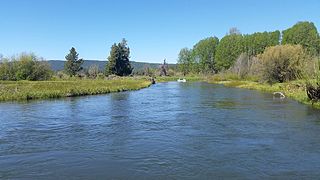
The Wood River is a short river in the southern region of the U.S. state of Oregon, and part of the Klamath Basin drainage. It flows 18 miles (29 km) through the Fremont-Winema National Forests, Bureau of Land Management land, and private property in southern Oregon. Its watershed consists of 220 square miles (570 km2) of conifer forest, rural pasture land, and marsh. The river provides habitat for many species of wildlife including an adfluvial (migratory) and resident populations of native Great Basin redband trout.
Caldor was a company town in El Dorado County, California. Caldor was linked to Diamond Springs by the Diamond and Caldor Railway. The community was named for the California Door Company, which owned and operated the town.

The Oregon Eastern Railway was a predecessor of the Southern Pacific Company that acquired or built most of the Natron Cutoff in northern California and southern Oregon, United States. It also made surveys and acquired right-of-way in eastern Oregon, which were subsequently sold to Union Pacific Railroad subsidiary Oregon–Washington Railroad and Navigation Company.
The Lower Williamson Gorge is located in the Winema National Forest north of Chiloquin in Klamath County, Oregon. It is formed where the Williamson River eroded its way from the Beaver Marsh area down through the escarpment north of Collier Memorial State Park into the Klamath Basin
Eagle Ridge County Park is a member of the Klamath County, Oregon, parks system. It is located on the Eagle Ridge peninsula fifteen miles west of Klamath Falls. Access is via four miles of gravel road. It consists of 634.88 acres of land, mostly hilly, on the shore of Upper Klamath Lake and Shoalwater Bay.

The Oregon and Northwestern Railroad (O&NW) is a defunct railroad in eastern Oregon in the United States. It ran 50.2 miles (80.8 km) from Hines north to Seneca, which is on the edge of the Malheur National Forest, over a total of 19 trestles.
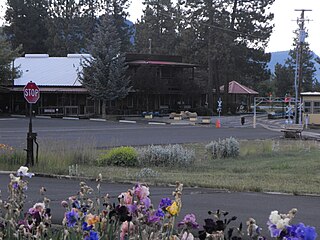
Train Mountain Railroad is the world's largest miniature hobbyist railroad near Chiloquin, Oregon, in Klamath County, which is in the south central region of Oregon. It is situated between Klamath Falls, Oregon, approximately 26 miles (42 km) to the south, and Crater Lake National Park to the north. Physical Location: 36941 South Chiloquin Road, Chiloquin, OR 97624, USA.
Klamath Northern Railway Company (KNOR) is a 10.6-mile (17.1 km) shortline railroad operating from Gilchrist, Oregon to Gilchrist Jct, Oregon where is connects with Union Pacific Railroad's Cascade Subdivision.

Truman Wesley Collins was an American businessman, civic leader, and philanthropist from the state of Oregon. He was born into a wealthy and influential business family. Collins graduated from Willamette University and then attended graduate school at Harvard University. After college, he returned to the Pacific Northwest to join his family's lumber business. Over the years, he was the top executive for a number of Collins family businesses. He was also an active leader in several timber-related industry groups and contributed to selected education and religious institutions.

Brooks-Scanlon Lumber Company was a lumber products company with large sawmills and significant land holdings in Minnesota, Florida, British Columbia, and Central Oregon. The company was formed in 1901 with its headquarters in Minneapolis, Minnesota. Beginning in 1915, its main lumber production facility was in Bend, Oregon. For many years, its Bend sawmill was one of the largest lumber producers in the world. In 1969, the company created Brooks Resources to broaden its business base beyond timber production. Brooks-Scanlon's Bend sawmill was closed in 1994. Today, Brooks Resources is the only vestige of the company that is still in business.














